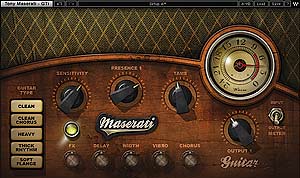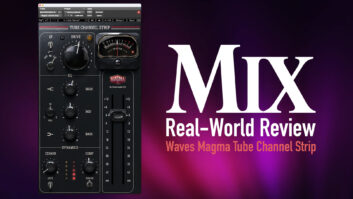
The Guitar Toner is one of six plug-ins designed for easily altering the tone via fixed processor chains.
The Tony Maserati Collection is the first in the Waves Signature Series of plug-ins. Each of these six plug-ins is a unique, preconfigured signal processor chain designed by New York-based mix-mëister Tony Maserati to achieve his hit-making sonic treatments of individual vocal and instrument tracks. The plug-ins have a huge range of processing power and macro-parameter controls to conform them to your own style and sonic aesthetics.
The six plug-ins are the VX1 Vocal Enhancer, B72 Bass Phattener, DRM Drum Slammer, GTi Guitar Toner, ACG Acoustic Guitar Designer and HMX Harmonics Generator. The GUIs look like Bakelite radios from the 1930s and ’40s — old Grundig Majestic shortwave receivers with huge knobs and buttons, ventilation slots revealing glowing “tubes” and round glass-faced radio dials for I/O VU meters. I tested them in Pro Tools HD3 Accel running Pro Tools 7.4 on an OS 10.4.11 Mac PPC. Each plug-in includes both mono in/stereo out and stereo in/out versions.
VX1 Vocal Enhancer
The intuitive control sets on the six plug-ins vary, depending on the specific task, except for a Sensitivity control that drives the chain harder and harder, right into a cool, distorted sound much like a hardware’s “blooming” tube stage. VX1 also has both Bass and Treble — fairly broad EQs like FM radio tone controls — and Compress applies more or less compression.
VX1 has three “contours” or modes configured for the most suitable vocal treatment predicated on song tempo. Conceptually and musically, this is a good way to initially set up a vocal processing and treatment chain. Contour 1 puts a vocal in a small studio or room; a slow ballad vocal might sound better on Contour 2 with its larger chamber and many pre-delay choices; and Contour 3 uses a small room with shorter delay options for uptempo songs.
Running under Contour 3, Compress becomes an Air control for adding pleasant high frequencies to the sound. There are six additional controls for adjusting delay and reverb parameters.
When first inserting VX1 on my female lead vocal track, I noticed a low-frequency roll-off even though the Bass and Treble knobs indicated “0.” The change in sound is instantly gratifying: None of these plugs come up flat or “swimming” in effects — delays and reverbs are dialed off but ready to add.
On a densely produced modern rock song, I liked switching through the three contours while listening to the whole mix. I saved presets of each contour after tweaking the FX, EQ and Compress controls — tweaks not saved when changing contours. I liked Contour 2 for this vocal in the verses and went with Contour 1 for the choruses as its slimmer, denser sound was a better fit for the track. Used sparingly, the delay and reverb sounds were good; the delays were on the short side with regeneration and the reverb sounds were plate-like. All of these effects are married together within the plug, so vocals take on a more cohesive, focused and “produced” sound as opposed to the result of using send/return to effect processors.
B72 Bass Phattener
The B72 worked well on a “flat-footed” bass track that had no wrong notes, just sub-zero personality. B72 has two modes or bass types: DI and Synth. It’s easy to get a slightly overdriven bass amp tone with plenty of squash and treble spank with DI. The Synth mode adds a buzzy stereo filter effect and a cheesy-sounding delay/reverb that was perfect for adding a mysterious backdrop to simple arpeggio guitar part. It also makes a cool vocal-trasher effect. It’s important to remember that any of the plugs can be used for any track. The B72 fixed up a DI bass quickly, and I liked it.
DRM Drum Slammer
The DRM is excellent for converting dull, lifeless R.I.P. drum sounds into punchy and bright drums. DRM’s processing modes are Kick, Snare Top, Snare Bottom, Hat, Toms, Overheads and Room Tracks. Although I don’t know exactly what’s going on behind the GUI, DRM duplicates the sound of equalizer and compressor chains I often used for these tracks. I liked the Snap control because it works subtly on the transient portion of drum hits — harder sounding without being just brighter. The hi-hat mode brought up some lightly played eighth notes without lifting spill from the rest of the kit. I replaced all the plug-ins I had on all my drum kit tracks with DRM, and all sounds matched well to what I had gotten previously using a lot of time and plug-ins.
GTi Guitar Toner
The GTi has five modes or guitar types: Clean, Clean Chorus, Heavy, Thick Rhythm and Soft Flange. As with all of these plugs, the most important initial control is Sensitivity to set gain staging — the right amount of “hair” from clean to not. Sensitivity, when cranked, brings up low-level ambience — room tone I had not heard before. GTi has a great-sounding chorus and vibrato with plenty of adjustability, while the Tame control acts like a limiter to contain peaks resulting from extreme EQ boosts. In general, all guitar tracks will emerge fatter and broader sounding through GTi — even direct guitar recordings. I used the Thick Rhythm contour to “beef up” a direct-recorded R&B rhythm guitar, making it sound amp-like. I ran the Sensitivity nearly wide open, and I liked the Univibe-esque vibrato sound but ended up switching to the chorus. I got a clean guitar sound much like a Roland Jazz Chorus amp.
ACG Acoustic Guitar Designer
ACG has two acoustic types of treatments. I was hesitant to tweak ACG1 type as it was so dialed in. I found acoustic guitars to be trimmed in the low frequencies in a very particular way that somehow retains a big bottom without boominess. There is also a kind of harmonic exciter, compression and short ambience happening — all tweakable, of course. The ACG2 type adds more compression and a wider ambience width — a lovely treatment for any acoustic guitar fighting for solo space in a busy track.
HMX Harmonics Generator
The HMX is a brilliant chain of processors that stereophonically spreads mono-sounding pads, synths and electric pianos. In addition to adding delays, it makes the pitch center ambiguous by way of a beautiful and watery-sounding chorus/flange effect. This was the one plug-in I also used as a send/return effect for several tracks that comprised a stereo pad. Used judiciously, HMX fattened and widened keyboards, backing vocals or strings.
Brilliant Chains of Command
What might at first seem like a dumbed-down, inflexible interface is actually an ingenious design that let me react musically and emotionally and less analytically. My left-brain was craving to know technically exactly what’s going on inside of the Maserati Collection plug-ins, but my right-brain is telling me it all sounds great.
Barry Rudolph is an L.A.-based recording engineer/mixer. Visitwww.barryrudolph.com.







